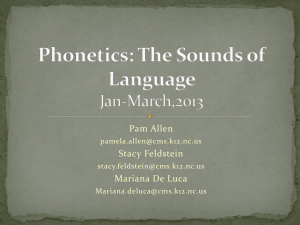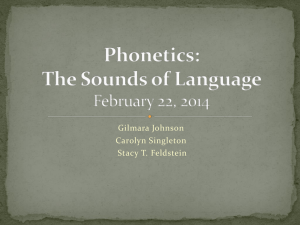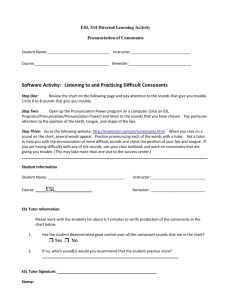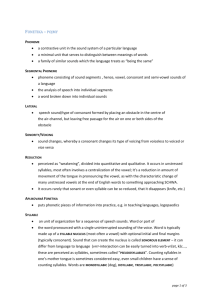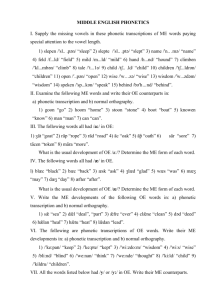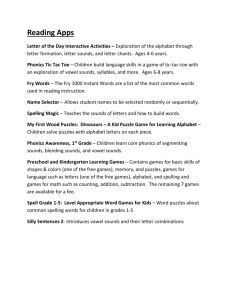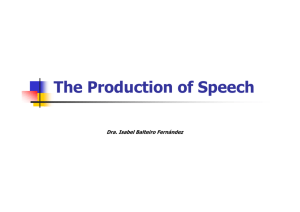Sunday November 3rd Quiz 1 Give the correct technical term for the
advertisement
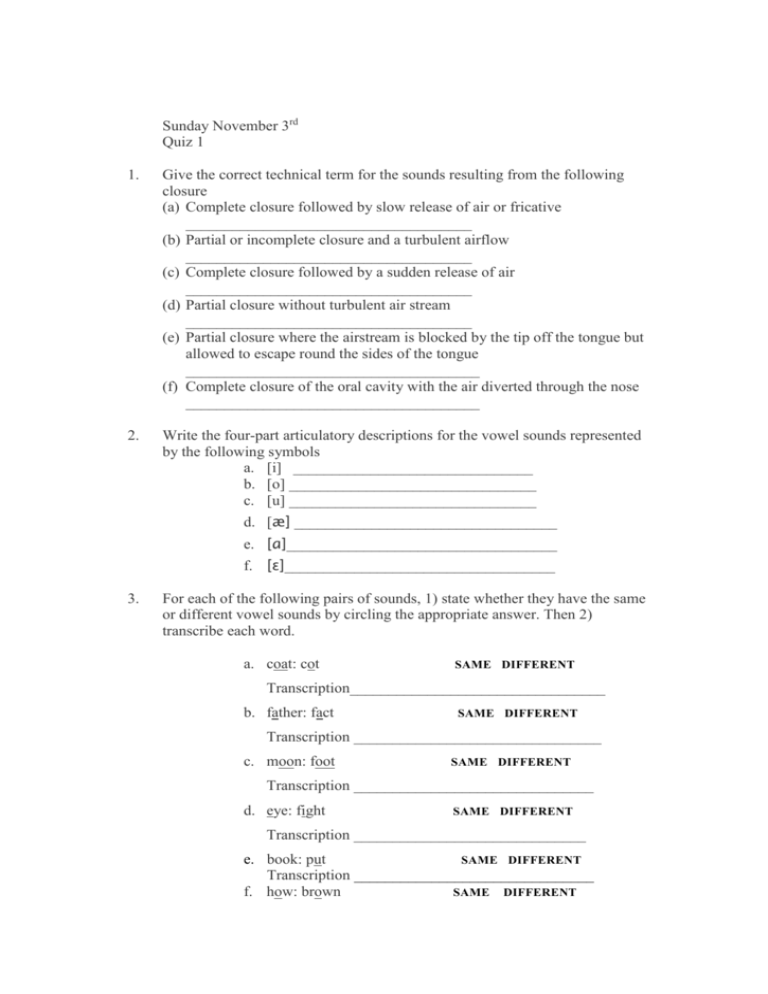
Sunday November 3rd Quiz 1 1. Give the correct technical term for the sounds resulting from the following closure (a) Complete closure followed by slow release of air or fricative _____________________________________ (b) Partial or incomplete closure and a turbulent airflow _____________________________________ (c) Complete closure followed by a sudden release of air _____________________________________ (d) Partial closure without turbulent air stream _____________________________________ (e) Partial closure where the airstream is blocked by the tip off the tongue but allowed to escape round the sides of the tongue ______________________________________ (f) Complete closure of the oral cavity with the air diverted through the nose ______________________________________ 2. Write the four-part articulatory descriptions for the vowel sounds represented by the following symbols a. [i] _______________________________ b. [o] ________________________________ c. [u] ________________________________ d. [æ] __________________________________ e. [ɑ]___________________________________ f. [ɛ]___________________________________ 3. For each of the following pairs of sounds, 1) state whether they have the same or different vowel sounds by circling the appropriate answer. Then 2) transcribe each word. a. coat: cot SAME DIFFERENT Transcription_________________________________ b. father: fact SAME DIFFERENT Transcription ________________________________ c. moon: foot SAME DIFFERENT Transcription _______________________________ d. eye: fight SAME DIFFERENT Transcription ______________________________ e. book: put SAME DIFFERENT Transcription _______________________________ f. how: brown SAME DIFFERENT Transcription: _____________________________ g. sink: fit SAME DIFFERENT Transcription ______________________________ h. month: love SAME DIFFERENT Transcription _______________________________ 4. Write the phonetic symbol that corresponds to each of the following descriptions a. voiceless bilabial stop [ ] b. low front vowel [ ] c. lateral liquid [ ] d. velar nasal [ ] e. voiced interdental fricative [ ] f. voiceless affricate [ ] g. palatal glide [ ] h. mid lax front vowel [ ] i. high back tense vowel [ ] j. voiceless alveolar stop [ ] 5. Each of the following sets contains an inappropriate member. Circle it and then say what phonetic features all the other members in each group share. Avoid obvious answers such as "consonant" or "vowel." 1. m, n, ŋ, d 2. n, d, z, t, f 3. ð, g, p, b, m, v 4. g, k, ŋ, n, w 5. ʃ, ʒ, z, f s, j 6. ɛ, ɔ, o, Ʊ, ə, ^, ɪ 6. _______________________________ ___________________________ ___________________________ ___________________________ ____________________________ _____________________________ Give the correct technical terms for the sounds made in the following ways: (a) Both lips coming together ______________________________ (b) The bottom lips and top teeth coming together__________________ (c) The tongue between the upper and lower teeth _____________________ (d) The tongue touching the hard palate______________________ (e) The tongue touching the soft palate______________________ (f) Sounds articulated with the back of the tongue______________________ (g) Vowels in which the body of the tongue is in the front part of the oral____________________________ Voicing refers to the “open” or “close” state of the a. velum b. glottis c. nasal cavity d. mouth 7. 8. The sounds [d] and [n] are ________________ in English. coronal labial dorsal retroflex a. b. c. d. 9. In the pronunciation of the /j/, the blade of the tongue approaches the a. hard palate b. soft palate c. velum d. uvular 10. The space between the focal folds is called a. Pharynx b. Larynx c. Glottis d. Velum 11. The soft palate must be ______________________during the production of a nasal sound a. Raised b. Lowered c. Closed d. nasalized The soft movable part of the palate at the back of themouth is the a. Glottis b. Velum c. Hard palate d. Alveolarridge 12. 13. Voicing refers to the vibration of the ____________________________ a. Velim b. Pharynx c. Focal folds d. Glottis 14. The active articulator for the retroflex is the ________________ of the tongue a. b. c. d. e. 15. 16. Tip Blade Front Back Root Sounds articulated with the tip or blade of the tongue raised towards the teeth or the alveolar ridge are called a. Labial b. Coronal c. Dorsal d. Alveolar _______________________ include phonetic features such as stress,length and intonation a. Strong features b. Weak features c. Segmental features d. Suprasegmental features 17. Variations in _________________________ are used in English to distinguish between a noun and a verb. a. Tone b. Pitch c. Stress d. Length 18. Variations in _______________________ are caused by an increase in the activity of the respiratory muscles (so that a greater amount of air is pushed out of the lungs) and in the activity of hr laryngeal muscles (so that there is a significant variation in pitch) a. Intonation b. Length c. Stress d. Pitch 19. _________________ is a vowel in which there is a change in quality during a single syllable a. Front vowel b. Lax vowel c. Diphthong d. Dorsum 20. When two sounds can be used to differentiate words, they are said to belongto different a. Sounds b. Syllables c. Phones d. Phonemes 21. 22. A set of words, each of which differs from all the others by only one sound, is called a a. Phonetic set b. Phonemic set c. Minimal set d. Rhyming set Sounds articulated with the tip or blade of the tongue raised toward the teeth or the alveolar ridge are called a. dorsal b. coronal c. glottal d. bilabial 23. In the pronunciation of /w/, the lips are rounded and at the same time, the back of the tongue approaches a. the velum b. the hard palate c. the glottis d. the alveolar ridge 24. Voicing refers to the “open” or “close” state of the e. velum f. glottis g. nasal cavity h. mouth
